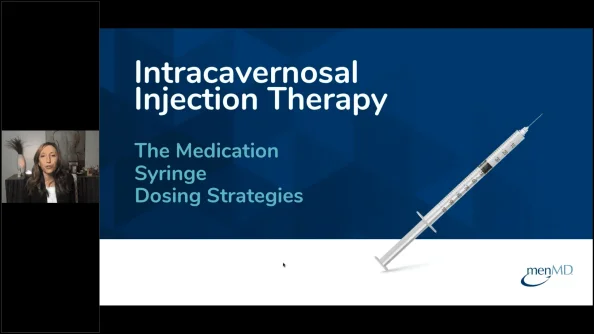Understanding Penile Injection Therapy: A Comprehensive Guide to Treatment
Based on a clinical webinar presented by Dr. Amy Perlman, a fellowship-trained men's sexual health urologist
Introduction
Erectile dysfunction (ED) affects millions of men, with many experiencing symptoms for three or more years before seeking comprehensive treatment. While oral medications like Viagra and Cialis are often the first line of treatment, penile injection therapy offers an effective alternative for men who don't respond adequately to pills or seek more reliable results.
Understanding Penile Anatomy and Function
Before exploring injection therapy, it's essential to understand how erections work. The penis consists of three main tubes: two erectile bodies that fill with blood during arousal, and the urethra through which men urinate. The erectile tissue functions like a sponge, surrounded by a fibrous covering called the tunica albuginea.
When aroused, nerves around the penis activate through the nitric oxide pathway, causing blood vessels to relax and allowing increased blood flow into the erectile tissue. As this tissue expands with blood, it compresses the veins that normally drain blood from the penis, creating the firmness necessary for intercourse.
How Injection Therapy Works
Penile injection therapy involves injecting medication directly into the erectile tissue to increase blood flow and achieve erections strong enough for sexual intercourse. This treatment bypasses the need for healthy nerve function, making it particularly valuable for men who have undergone prostate surgery or have other conditions affecting nerve pathways.
Common Medications Used
Single Agent Medications:
- Alprostadil (Prostaglandin E1): Works by inhibiting enzymes to increase blood flow
- Papaverine: Also works by inhibiting enzymes
Combination Medications:
- Bi-mix: Combines papaverine and phentolamine
- Tri-mix: Contains all three medications - alprostadil, papaverine, and phentolamine
Phentolamine acts differently by blocking the "off switch" for erections. When men typically experience orgasm, the sympathetic nervous system releases noradrenaline to end the erection. Phentolamine prevents this process, helping maintain the erection longer.
Why Combination Therapy Often Works Better
Many urologists prefer tri-mix over single-agent alprostadil because it allows for lower doses of each individual medication while maintaining effectiveness. This is particularly important because alprostadil can cause a dull aching sensation in about 20% of men when used at higher doses. By combining medications, the alprostadil dose can be reduced while other medications provide additional erectile support.
Injection Technique and Safety
Equipment and Preparation
Injection therapy uses very small needles, similar to those used by diabetics for insulin injections. The equipment includes:
- A small syringe (typically 1 mL capacity)
- A fine needle (higher gauge numbers indicate smaller needles)
- Alcohol prep pads
- A sharps container for safe needle disposal
Proper Injection Technique
Location: Inject on either side of the penis at the 10 o'clock or 2 o'clock position, avoiding:
- The top of the penis (where nerves and blood vessels are located)
- The bottom of the penis (where the urethra is located)
- Large visible veins
Procedure:
- Clean the injection site with alcohol
- Insert the needle at a 90-degree angle toward the base of the penis
- Inject slowly and remove the needle
- Apply pressure for 1-2 minutes to prevent bleeding
- Dispose of the needle safely
Important Safety Notes:
- Only inject one side of the penis (medication will affect both erectile bodies)
- Alternate injection sites to prevent scar tissue formation
- Stand during and after injection to help medication distribution
Dosing and Titration
Starting Low and Going Slow
Unlike oral medications where higher starting doses are often recommended, injection therapy requires a cautious approach. Starting with low doses and gradually increasing prevents the serious complication of priapism (prolonged, painful erection requiring emergency treatment).
Typical Dosing Protocol
- Start with a low dose (often 10-20 units for tri-mix)
- Increase by 10 units every 2-3 days if needed
- Maximum dose varies by formulation and individual patient
- Never exceed prescribed maximum dose
- Don't inject more than once every 24 hours (preferably every 48 hours)
Recognizing Optimal Dosing
The ideal result is a full erection that naturally subsides within 2-4 hours. Signs that adjustment is needed:
- Dose too low: Partial erection insufficient for intercourse
- Dose too high: Erection lasting more than 4 hours or causing significant pain
Storage and Handling
Refrigeration Requirements: Most multi-agent formulations (bi-mix and tri-mix) must be refrigerated and remain effective for 28 days after first use.
Travel Considerations: Many injection kits come with cold packs for transport. Single-agent alprostadil often comes in forms that don't require refrigeration, making them convenient for travel.
Potential Side Effects and Complications
Common Side Effects
- Mild pain or aching: Particularly with alprostadil, usually temporary
- Minor bleeding: More common in patients taking blood thinners
- Bruising at injection site: Usually resolves quickly
Serious Complications
Priapism: Erection lasting more than 4 hours, requiring emergency treatment. Risk factors include:
- Using doses that are too high
- Injecting too frequently
- Combining with other erectile dysfunction treatments without medical supervision
Penile Fibrosis: Development of scar tissue with long-term use, particularly associated with papaverine. This can lead to:
- Decreased effectiveness over time
- Penile curvature
- Reduced penile length or girth
Frequency and Long-term Use
Recommended Usage Pattern
- Maximum frequency: Every other day
- Ideal pattern: 3 times per week (Monday, Wednesday, Friday)
- Can be used for penile rehabilitation even without planned sexual activity
"Use It or Lose It" Principle
Regular blood flow to the penis is crucial for maintaining healthy erectile tissue. Young men naturally experience multiple nighttime erections that exercise the penile tissue. As men age or develop medical conditions, these natural erections decrease, leading to tissue changes that can affect size and function.
Regular use of injection therapy, vacuum devices, or other treatments helps maintain penile health by ensuring adequate blood flow and tissue oxygenation.
Combining Therapies for Maximum Effectiveness
Common Combinations
Vacuum Pumps and Injections: Many patients benefit from using both therapies together. The vacuum pump can be used either before injection (to enhance medication distribution) or after injection (to maximize erection quality).
Oral Medications and Injections: Under medical supervision, some patients successfully combine low-dose oral medications with injection therapy, as they work through different mechanisms.
Penile Rehabilitation Programs: Comprehensive approaches often include:
- Regular injection therapy
- Vacuum pump therapy for tissue stretching
- Traction devices (for men with penile curvature)
- Pelvic floor physical therapy
Special Considerations
Post-Prostate Surgery Patients
Men who have undergone prostate surgery often benefit significantly from injection therapy because:
- The medications don't require intact nerve pathways
- Early use can help prevent penile tissue changes
- Effectiveness may improve as nerves heal over 1-2 years post-surgery
Age Considerations
There is no upper age limit for injection therapy. Men in their 80s and 90s can safely use these medications if sexual function remains important to them and their partners.
Managing Expectations
Success with injection therapy often requires patience and communication with healthcare providers. Factors that can affect effectiveness include:
- Stress levels and mental health
- Sleep quality
- Other medications
- Overall health status
- Relationship dynamics
When to Consider Alternative Treatments
Indications for Penile Implants
Men might consider penile implant surgery if they:
- Develop significant scar tissue from injections
- Experience persistent side effects
- Require increasingly higher doses
- Prefer a more permanent solution
- Have failed multiple other therapies
Complementary Treatments
Vacuum Pumps: Excellent for penile rehabilitation and can be used alone or with injections
Traction Devices: Helpful for men with penile curvature or those wanting to prevent length loss
Pelvic Floor Physical Therapy: Can improve erection quality and orgasmic function
Patient Education and Support
Working with Healthcare Providers
Successful injection therapy requires ongoing communication with urologists or specialized providers who can:
- Adjust formulations based on response
- Monitor for complications
- Provide education and support
- Coordinate combination therapies
Partner Involvement
Sexual dysfunction affects couples, not just individuals. Successful treatment often involves:
- Open communication about expectations and goals
- Partner education about the treatment process
- Incorporation of injection therapy into foreplay and intimacy
- Realistic goal-setting for sexual satisfaction
Conclusion
Penile injection therapy represents a highly effective treatment option for erectile dysfunction, offering reliable results for men who don't respond adequately to oral medications or prefer more predictable outcomes. While the concept of self-injection may initially seem daunting, most men find the process manageable and are pleased with the results.
Success with injection therapy requires proper education, careful dose titration, attention to safety protocols, and ongoing medical supervision. When used appropriately, these medications can significantly improve quality of life and intimate relationships.
The key message for men considering this therapy is that sexual health remains important at any age, and multiple effective treatment options exist. Working with knowledgeable healthcare providers who offer comprehensive solutions ensures the best possible outcomes for restoring sexual function and maintaining penile health.
This article is based on educational content and should not replace individual medical consultation. Men interested in injection therapy should consult with qualified healthcare providers specializing in sexual medicine.













